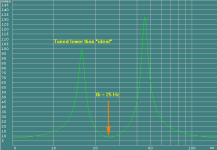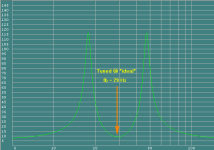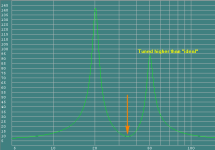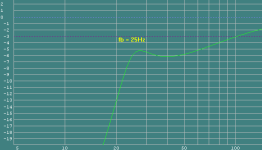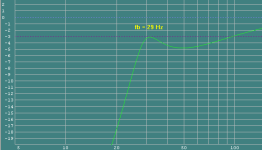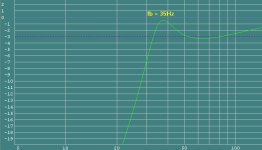Hi there.
Trying to wrap my head around some of the data I've been logging for the past couple years... I compete in a car audio format that limits the amount of power (and cone area) we can use in a given class - so basically trying to build the most efficient setup possible for reproducing a single tone (typically between 58-60hz in my hatchback).
The metering equipment I have available are a TermLab, Fluke multimeter, and Fluke ammeter. I also have a Dayton Audio DATS that I typically take a impedance sweep with as well.
The current ported enclosure(s) I test with are pretty undersized (less than 2 cubes for three 10" woofers) to get the enclosure 'wanting' to peak around the desired 58-60hz. Depending on which enclosure I'm playing with, it has either a pair of 4" aeroports, or a single 6" aeroport. I then test - and systematically extend the port and take all the reading over and over, till I hit the point of diminishing return. This usually results in the port being decently long (~18"). When I look at the sweet in DATS, the point of highest efficiency occurs on the 2nd peak - but not necessarily at the tip, usually on the rising side (just a bit to the left of the 'peak').
Basically - what I've been noticing is the longer I extend the port(s), the higher the impedance peak - and more efficient the SPL to power ratio - (to an extent...), but at some point, I've altered the tuning severely enough that the score deteriorates.
So here's what I'm trying to understand... is the left peak the woofer/enclosure resonance, and the right the port resonance - or do I have that backwards? A smaller enclosure would raise the peak(s)? Less port area would also raise the peaks (to a degree)?
Trying to wrap my head around some of the data I've been logging for the past couple years... I compete in a car audio format that limits the amount of power (and cone area) we can use in a given class - so basically trying to build the most efficient setup possible for reproducing a single tone (typically between 58-60hz in my hatchback).
The metering equipment I have available are a TermLab, Fluke multimeter, and Fluke ammeter. I also have a Dayton Audio DATS that I typically take a impedance sweep with as well.
The current ported enclosure(s) I test with are pretty undersized (less than 2 cubes for three 10" woofers) to get the enclosure 'wanting' to peak around the desired 58-60hz. Depending on which enclosure I'm playing with, it has either a pair of 4" aeroports, or a single 6" aeroport. I then test - and systematically extend the port and take all the reading over and over, till I hit the point of diminishing return. This usually results in the port being decently long (~18"). When I look at the sweet in DATS, the point of highest efficiency occurs on the 2nd peak - but not necessarily at the tip, usually on the rising side (just a bit to the left of the 'peak').
Basically - what I've been noticing is the longer I extend the port(s), the higher the impedance peak - and more efficient the SPL to power ratio - (to an extent...), but at some point, I've altered the tuning severely enough that the score deteriorates.
So here's what I'm trying to understand... is the left peak the woofer/enclosure resonance, and the right the port resonance - or do I have that backwards? A smaller enclosure would raise the peak(s)? Less port area would also raise the peaks (to a degree)?
Last edited:
Ported enclosure has two impedance peaks and a dip between. That dip is both the resonant frequency of the woofer (minimum movement) AND the port (maximum output) - it is the tuning/resonant frequency of the ported box. Optimal resonant frequency depends on Thiele-Small parameters and the size of the box and the tube. For maximum efficiency choose more port area.
This may be a crazy idea, and maybe not even legal. But what about tuning the second impedance peak to the drive frequency, and use a transformer to bring it down to 1 ohm or whatever? That would give you one hell of a boost on the same amplifier -- for that ONE tone. You could not run it at the dip at all - the amp really wouldn't like it. But it would be loud as hell at the anti-resonance, where the box really *is* efficient.
You'd need a driver with as high a Qms as you could find and the box would have to be braced VERY well to keep mechanical losses down (that influences the peak Z).
You'd need a driver with as high a Qms as you could find and the box would have to be braced VERY well to keep mechanical losses down (that influences the peak Z).
Thank you for the explanation.
I'm using (3) 10" Kicker L7's in this setup - which get quite peaky in a box this small (good thing for burps).
I've currently got a pair of 4" aeroports - so you think adding a third would be an increase in spl? What's that going to do to my power though? Won't more port area lower the apparent impedance at the amp?
I'm using (3) 10" Kicker L7's in this setup - which get quite peaky in a box this small (good thing for burps).
I've currently got a pair of 4" aeroports - so you think adding a third would be an increase in spl? What's that going to do to my power though? Won't more port area lower the apparent impedance at the amp?
Ported enclosure has two impedance peaks and a dip between. That dip is both the resonant frequency of the woofer (minimum movement) AND the port (maximum output) - it is the tuning/resonant frequency of the ported box. Optimal resonant frequency depends on Thiele-Small parameters and the size of the box and the tube. For maximum efficiency choose more port area.
Will try.
My two concerns with more port area are
1) won't the apparent impedance at the amp drop - and thus the amp want to put out more power?
2) The port length is getting fairly long - going to start running into physical limitations in the car going too much longer (which I would have to do when adding more port area).
Thoughts?
My two concerns with more port area are
1) won't the apparent impedance at the amp drop - and thus the amp want to put out more power?
2) The port length is getting fairly long - going to start running into physical limitations in the car going too much longer (which I would have to do when adding more port area).
Thoughts?
I'd definitely go for more port area.
Get the impedance dip around 60Hz, and you should be able to really make some noise.
Consider a 4th order bandpass, too. Play around in WinISD to get a feel for what does what.
Chris
Unfortunately these woofers (L7's) are not very suited for a 4th (high VAS), probably better performance in a 6th, though I'm a bit limited in space for something like that...
I'd definitely go for more port area.
Get the impedance dip around 60Hz, and you should be able to really make some noise.
Consider a 4th order bandpass, too. Play around in WinISD to get a feel for what does what.
Chris
Three 4" ports are better than two ports, but increase in the SPL is marginal, more important is a good flow of ear without turbulence. As you increase port area (three ports) you must increase the tube length - check if there is enough space inside the box.Thank you for the explanation.
I'm using (3) 10" Kicker L7's in this setup - which get quite peaky in a box this small (good thing for burps).
I've currently got a pair of 4" aeroports - so you think adding a third would be an increase in spl? What's that going to do to my power though? Won't more port area lower the apparent impedance at the amp?
One 6" has more port area than two 4" ports.
More port area will not lower the impedance.
Something important to understand is exactly what the impedance curve means. A ported box has two resonances (not one!), but has one tuning frequency. As you may know, a resonance is when the stiffness and mass are equal in magnitude, yet sum to zero. You have the stiffness of the driver, given as Cms (compliance = 1/stiffness), the moving mass of the driver, the stiffness of the air in the box, and then the mass of air in the port. Think of the port as a large barrel of air that moves as a solid unit. That solid unit is modeled as a mass. This summing to zero business happens twice in a ported box, hence you get two peaks:
Fhigh: This is the higher frequency peak above the tuning frequency (your right peak). This is the stiffness of the driver's suspension and the stiffness of the air in the enclosure balancing the moving mass of the driver. This is pretty similar to the single peak in a sealed enclosure as the port is not really coming to party yet.
Flow: This is the frequency peak below the tuning frequency. This guy is the stiffness of the driver's suspension balancing out the moving mass of the driver and the mass of air in the port. The larger the port, the more mass there is. It's for this reason that not all tunings are created equal: port area does matter along with tuning.
The low point in between, as you already know, is the tuning frequency of the enclosure. While the distance between the peaks depends on the chosen drivers, the point where the minimum occurs is a function only of the box/port combination. It matters not what's driving it.
The peaks are usually at some combination of heights. When the first peak (higher frequency) is equal in magnitude to the lower peak, you get the indication that the box tuning is identical to the Fs of your woofer. When the first peak is lower in magnitude, this means the box tuning is higher than the woofer Fs. When the opposite, that is, the lowest frequency peak is the smallest, the box is tuned below woofer Fs.
When you're at a resonance (NOTE: not at the tuning frequency), all that's in play are the resistive losses in the system. High Qms drivers (low resistive losses) will give you large impedance peaks for this reason. What you're noticing, that is when you extend the port, is that you're adding more and more mass for the woofers to drive. That SPL keeps getting higher and higher as you reach the point where the suspension can no longer fully keep up with its own mass and the port mass. Once the port mass becomes too great, the efficiency falls. You're able to do this iteratively because you have 3 woofers in a small enclosure, and it takes a large amount of port mass to cancel out the high box stiffness with the driver's own stiffness. In other words: your box is incredibly stiff, so you need a lot of port mass to create that second resonance.
To put this another way, by continually extending that port, you're optimizing the system to the tuning frequency that you want. After a certain point, the driver suspension can no longer continue to keep up with the mass of air moving out of the port, and the drivers start to lose control over it. Your efficiency starts to fall at this point.
Ported boxes are fascinating things. I recommend a book, Bullock on Boxes, which gives great insight into ported enclosures. The original Richard Small and Neville Thiele vented box papers are still required reading for every loudspeaker enthusiast, in my mind.
Hopefully this helps some.
Fhigh: This is the higher frequency peak above the tuning frequency (your right peak). This is the stiffness of the driver's suspension and the stiffness of the air in the enclosure balancing the moving mass of the driver. This is pretty similar to the single peak in a sealed enclosure as the port is not really coming to party yet.
Flow: This is the frequency peak below the tuning frequency. This guy is the stiffness of the driver's suspension balancing out the moving mass of the driver and the mass of air in the port. The larger the port, the more mass there is. It's for this reason that not all tunings are created equal: port area does matter along with tuning.
The low point in between, as you already know, is the tuning frequency of the enclosure. While the distance between the peaks depends on the chosen drivers, the point where the minimum occurs is a function only of the box/port combination. It matters not what's driving it.
The peaks are usually at some combination of heights. When the first peak (higher frequency) is equal in magnitude to the lower peak, you get the indication that the box tuning is identical to the Fs of your woofer. When the first peak is lower in magnitude, this means the box tuning is higher than the woofer Fs. When the opposite, that is, the lowest frequency peak is the smallest, the box is tuned below woofer Fs.
When you're at a resonance (NOTE: not at the tuning frequency), all that's in play are the resistive losses in the system. High Qms drivers (low resistive losses) will give you large impedance peaks for this reason. What you're noticing, that is when you extend the port, is that you're adding more and more mass for the woofers to drive. That SPL keeps getting higher and higher as you reach the point where the suspension can no longer fully keep up with its own mass and the port mass. Once the port mass becomes too great, the efficiency falls. You're able to do this iteratively because you have 3 woofers in a small enclosure, and it takes a large amount of port mass to cancel out the high box stiffness with the driver's own stiffness. In other words: your box is incredibly stiff, so you need a lot of port mass to create that second resonance.
To put this another way, by continually extending that port, you're optimizing the system to the tuning frequency that you want. After a certain point, the driver suspension can no longer continue to keep up with the mass of air moving out of the port, and the drivers start to lose control over it. Your efficiency starts to fall at this point.
Ported boxes are fascinating things. I recommend a book, Bullock on Boxes, which gives great insight into ported enclosures. The original Richard Small and Neville Thiele vented box papers are still required reading for every loudspeaker enthusiast, in my mind.
Hopefully this helps some.
A picture is worth a thousand words, & here's 6 ! They are all with the same driver in the same box, just tuned to different fb's.
Attachments
What is the limit - nominal amplifier power at resistive 4 ohms, or real (measured) amplifier power at the loudspeaker impedance at specific frequency?I compete in a car audio format that limits the amount of power
Right, two impedance resonances are electrical impedance peaks. Ported box impedance dip is single and usually is referred as acoustical resonance - maximum port output and minimum driver movement.A ported box has two resonances (not one!), but has one tuning frequency.
(Just to be clear about the use of the word box resonance.)
The small enclosure size is to get my note to the desired range (58-60hz) while still utilizing a long port (where I get peak efficiency).
You need a much larger box than 2 cubic feet for maximum efficiency and maximum SPL.
(Edit for post #9: flow of air, not ear!)
Looking at my test results this morning, enlarging the port (from a single 6" diameter to a single 7" diameter) lowered my impedance at 60hz by a fairly significant amount (5ohms to 3.12 ohms).
I lost about 0.7db - while power increased from 416VA to 666VA, resulting in an efficiency loss of 3db. =(
thoughts?
I lost about 0.7db - while power increased from 416VA to 666VA, resulting in an efficiency loss of 3db. =(
thoughts?
Three 4" ports are better than two ports, but increase in the SPL is marginal, more important is a good flow of ear without turbulence. As you increase port area (three ports) you must increase the tube length - check if there is enough space inside the box.
One 6" has more port area than two 4" ports.
More port area will not lower the impedance.
The limit in my class is 500 VA (measured at the amp).
My best setup to date is either 3L710s or 2soloX10s, both do about same score - 146db clamped at 500VA.
My best setup to date is either 3L710s or 2soloX10s, both do about same score - 146db clamped at 500VA.
What is the limit - nominal amplifier power at resistive 4 ohms, or real (measured) amplifier power at the loudspeaker impedance at specific frequency?
I have WinISD - but in the interest of time, just trying to make a ported enclosure work. After this weekend I would have more time to mess with bandpass though...
Can you simulate a series-tuned 6th order bandpass?
Those are the ultimate in one-note boom.
Hope your drivers are decent when it comes to heat dissipation - cone movement is minimal at the tuning frequency.
Chris
Thank you for the extensive and informative post - digesting it with my brain...
The second part of the equation of course - is figuring out 'what' do I do now...
=)
The second part of the equation of course - is figuring out 'what' do I do now...
=)
Something important to understand is exactly what the impedance curve means. A ported box has two resonances (not one!), but has one tuning frequency. As you may know, a resonance is when the stiffness and mass are equal in magnitude, yet sum to zero. You have the stiffness of the driver, given as Cms (compliance = 1/stiffness), the moving mass of the driver, the stiffness of the air in the box, and then the mass of air in the port. Think of the port as a large barrel of air that moves as a solid unit. That solid unit is modeled as a mass. This summing to zero business happens twice in a ported box, hence you get two peaks:
Fhigh: This is the higher frequency peak above the tuning frequency (your right peak). This is the stiffness of the driver's suspension and the stiffness of the air in the enclosure balancing the moving mass of the driver. This is pretty similar to the single peak in a sealed enclosure as the port is not really coming to party yet.
Flow: This is the frequency peak below the tuning frequency. This guy is the stiffness of the driver's suspension balancing out the moving mass of the driver and the mass of air in the port. The larger the port, the more mass there is. It's for this reason that not all tunings are created equal: port area does matter along with tuning.
The low point in between, as you already know, is the tuning frequency of the enclosure. While the distance between the peaks depends on the chosen drivers, the point where the minimum occurs is a function only of the box/port combination. It matters not what's driving it.
The peaks are usually at some combination of heights. When the first peak (higher frequency) is equal in magnitude to the lower peak, you get the indication that the box tuning is identical to the Fs of your woofer. When the first peak is lower in magnitude, this means the box tuning is higher than the woofer Fs. When the opposite, that is, the lowest frequency peak is the smallest, the box is tuned below woofer Fs.
When you're at a resonance (NOTE: not at the tuning frequency), all that's in play are the resistive losses in the system. High Qms drivers (low resistive losses) will give you large impedance peaks for this reason. What you're noticing, that is when you extend the port, is that you're adding more and more mass for the woofers to drive. That SPL keeps getting higher and higher as you reach the point where the suspension can no longer fully keep up with its own mass and the port mass. Once the port mass becomes too great, the efficiency falls. You're able to do this iteratively because you have 3 woofers in a small enclosure, and it takes a large amount of port mass to cancel out the high box stiffness with the driver's own stiffness. In other words: your box is incredibly stiff, so you need a lot of port mass to create that second resonance.
To put this another way, by continually extending that port, you're optimizing the system to the tuning frequency that you want. After a certain point, the driver suspension can no longer continue to keep up with the mass of air moving out of the port, and the drivers start to lose control over it. Your efficiency starts to fall at this point.
Ported boxes are fascinating things. I recommend a book, Bullock on Boxes, which gives great insight into ported enclosures. The original Richard Small and Neville Thiele vented box papers are still required reading for every loudspeaker enthusiast, in my mind.
Hopefully this helps some.
- Status
- This old topic is closed. If you want to reopen this topic, contact a moderator using the "Report Post" button.
- Home
- Loudspeakers
- Subwoofers
- Understanding - and exploiting the impedance curve?
